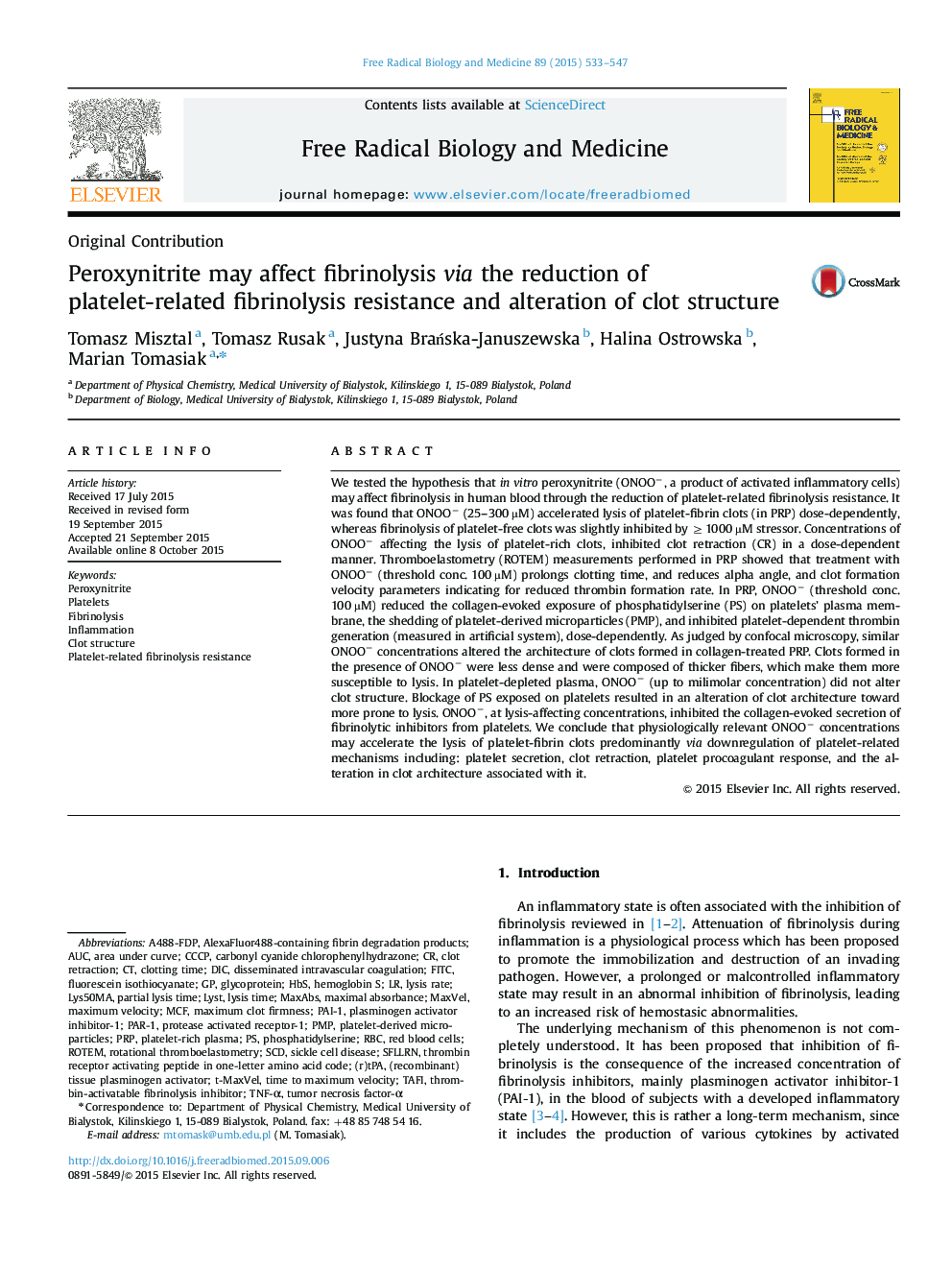| Article ID | Journal | Published Year | Pages | File Type |
|---|---|---|---|---|
| 8268645 | Free Radical Biology and Medicine | 2015 | 15 Pages |
Abstract
We tested the hypothesis that in vitro peroxynitrite (ONOOâ, a product of activated inflammatory cells) may affect fibrinolysis in human blood through the reduction of platelet-related fibrinolysis resistance. It was found that ONOOâ (25-300 µM) accelerated lysis of platelet-fibrin clots (in PRP) dose-dependently, whereas fibrinolysis of platelet-free clots was slightly inhibited by â¥1000 µM stressor. Concentrations of ONOOâ affecting the lysis of platelet-rich clots, inhibited clot retraction (CR) in a dose-dependent manner. Thromboelastometry (ROTEM) measurements performed in PRP showed that treatment with ONOOâ (threshold conc. 100 µM) prolongs clotting time, and reduces alpha angle, and clot formation velocity parameters indicating for reduced thrombin formation rate. In PRP, ONOOâ (threshold conc. 100 µM) reduced the collagen-evoked exposure of phosphatidylserine (PS) on platelets' plasma membrane, the shedding of platelet-derived microparticles (PMP), and inhibited platelet-dependent thrombin generation (measured in artificial system), dose-dependently. As judged by confocal microscopy, similar ONOOâ concentrations altered the architecture of clots formed in collagen-treated PRP. Clots formed in the presence of ONOOâ were less dense and were composed of thicker fibers, which make them more susceptible to lysis. In platelet-depleted plasma, ONOOâ (up to milimolar concentration) did not alter clot structure. Blockage of PS exposed on platelets resulted in an alteration of clot architecture toward more prone to lysis. ONOOâ, at lysis-affecting concentrations, inhibited the collagen-evoked secretion of fibrinolytic inhibitors from platelets. We conclude that physiologically relevant ONOOâ concentrations may accelerate the lysis of platelet-fibrin clots predominantly via downregulation of platelet-related mechanisms including: platelet secretion, clot retraction, platelet procoagulant response, and the alteration in clot architecture associated with it.
Keywords
carbonyl cyanide chlorophenylhydrazonePAI-1CCCPHBSPrPTAFIPAR-1RBCLYSTSCDMCFDICSFLLRNPMPFITCRed blood cellsAUCROTEMinflammationdisseminated intravascular coagulationSickle cell diseaseRotational thromboelastometrytumor necrosis factor-αmaximum velocityMaximum clot firmnessClotting timeClot structureTNF-αPhosphatidylserinefluorescein isothiocyanateFibrinolysisclot retractionarea under curvePlasminogen activator inhibitor-1thrombin-activatable fibrinolysis inhibitorHemoglobin SProtease activated receptor-1Peroxynitriteplatelet-rich plasmaPlateletsplatelet-derived microparticlesGlycoprotein
Related Topics
Life Sciences
Biochemistry, Genetics and Molecular Biology
Ageing
Authors
Tomasz Misztal, Tomasz Rusak, Justyna BraÅska-Januszewska, Halina Ostrowska, Marian Tomasiak,
